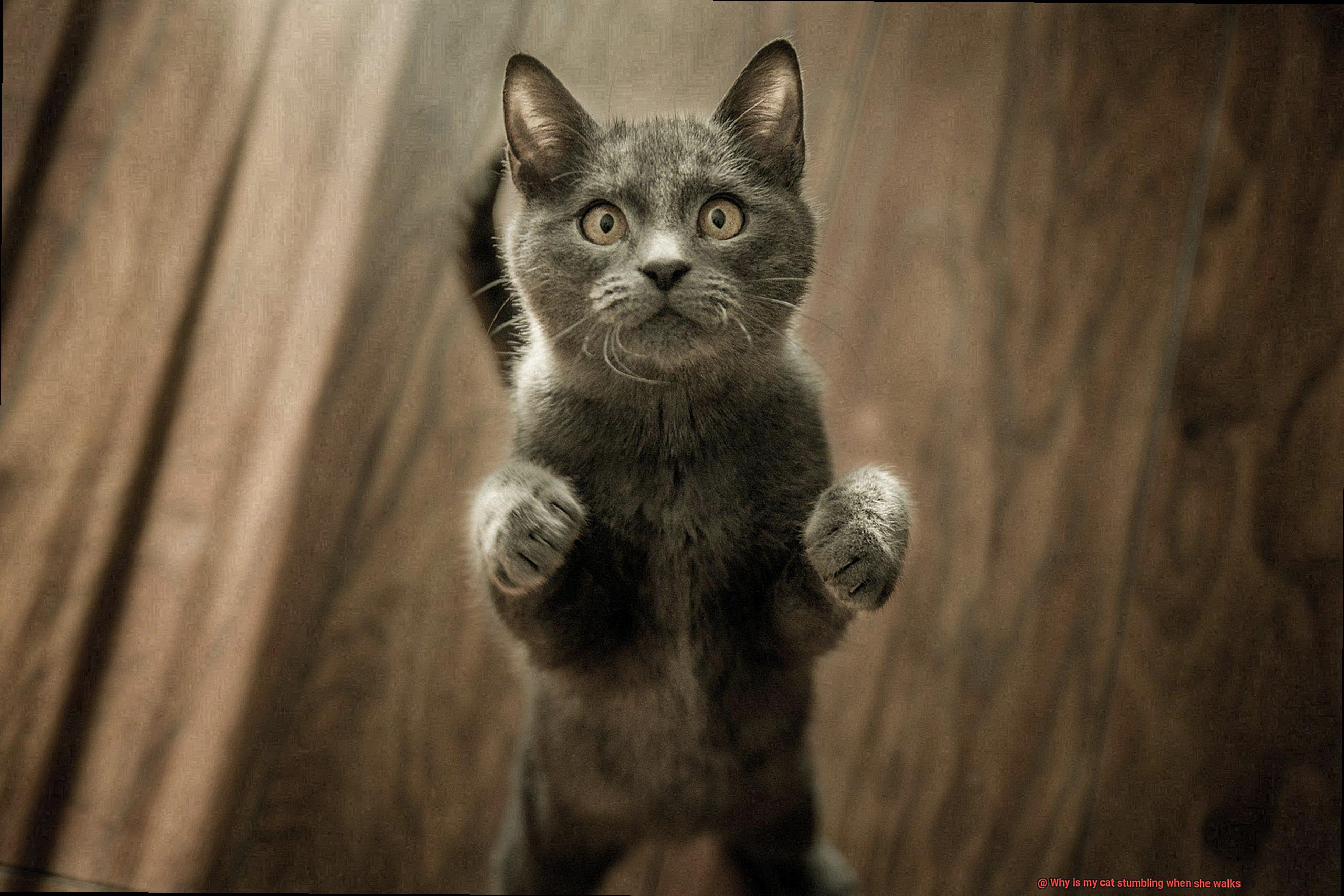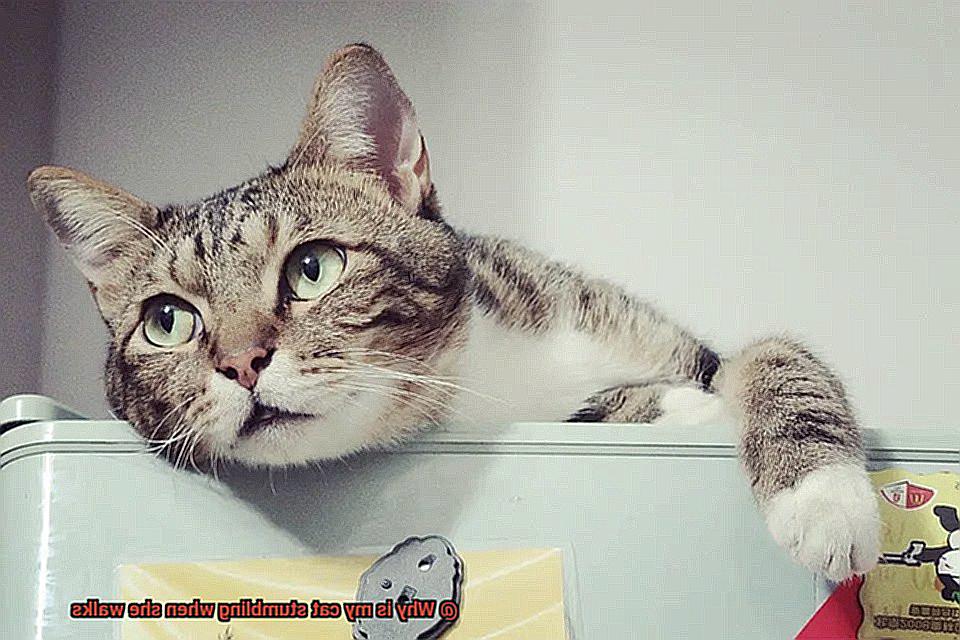As pet parents, we all strive to keep our feline friends healthy and happy. But what if your cat is stumbling while walking? It can be concerning and prompt a visit to the vet. However, before you rush to the clinic, it’s important to understand why this might be happening.
There are several reasons why your cat may lose their balance or stumble. It could be due to old age, an injury or an underlying medical condition. In some cases, it could also indicate a more severe neurological problem that requires immediate attention.
In this blog post, we’ll delve into some of the common causes of stumbling in cats. We’ll discuss the tell-tale signs to look out for and offer tips on how you can help your furry friend regain their balance. Whether you’re a seasoned cat owner or new to the game, understanding why your cat is experiencing this issue is crucial.
So if you’re eager to learn more about why your cat is stumbling when they walk, then keep reading. Our guide will equip you with all the knowledge and tools necessary to get your feline back on their paws in no time.
What Causes a Cat to Stumble When Walking?
Cats are known for their elegance and poise, so it can be alarming when your feline friend begins to stumble while walking. Frequent stumbling could indicate an underlying medical condition that requires attention from a veterinarian. Here are some of the potential causes of a cat stumbling when walking:
- Neurological Disorders: A common reason why cats stumble is due to neurological disorders such as vestibular disease, brain tumors, or seizures that affect the cat’s balance and coordination. These disorders can be caused by head trauma, infections that affect the nervous system, or other underlying medical conditions.
- Arthritis: Arthritis is a common condition in older cats that causes inflammation in the joints, making it painful for them to walk. This pain can result in a loss of balance and coordination, leading to stumbling and difficulty moving around.
- Injuries or Trauma: If your cat has recently suffered an injury or trauma, they may experience instability and loss of coordination in their limbs, leading to stumbling while walking.
- Medications: Certain medications used to treat various health conditions in cats can cause dizziness or disorientation, leading to stumbling while walking. If your cat has recently started taking medication and is experiencing this symptom, it is advisable to consult with your veterinarian.
- Aging: As cats age, they may experience a decline in their physical abilities, including their balance and coordination. Senior cats may develop diseases such as kidney or liver disease, which can affect their overall health and cause them to stumble when walking.

It is essential to seek veterinary care if you notice your cat stumbling frequently. The vet will perform a thorough physical examination and run diagnostic tests to determine the root cause of the problem. Once the underlying issue has been identified, appropriate treatment plans will be recommended to improve your cat’s condition.
Neurological Disorders
It’s a distressing sight to see your feline friend stumble or have difficulty walking. Neurological disorders, which affect the brain, spinal cord, or nerves in a cat’s body, can be one possible explanation for this behavior. These disorders can cause a range of symptoms that affect coordination, balance, and strength.
One of the most common neurological disorders that may cause stumbling in cats is cerebellar hypoplasia. This condition occurs when a kitten’s cerebellum does not fully develop in the womb or is damaged during birth. Cats with cerebellar hypoplasia struggle with balance and coordination, leading to frequent stumbling or falling.
Another potential neurological disorder that can cause stumbling in cats is feline vestibular syndrome. This condition affects the inner ear and can result in symptoms such as head tilting, loss of balance, and difficulty walking. Although its exact cause remains unknown, it is believed to be related to inflammation or infection of the inner ear.
Spinal cord injuries, brain tumors, and infections like toxoplasmosis or FIP are other neurological disorders that may cause stumbling in cats. These conditions can be severe and even life-threatening, so it’s crucial to seek veterinary care immediately if you notice any unusual symptoms.
If you notice your cat struggling with coordination or having difficulty walking, don’t hesitate to bring them to the vet. A thorough physical examination and diagnostic tests can help determine the underlying cause of your cat’s symptoms and guide appropriate treatment. With prompt attention and proper care, many neurological disorders can be managed effectively, allowing your feline friend to live a comfortable and happy life.
Arthritis
As our feline friends grow older, they may begin to experience a common condition known as arthritis. Arthritis can cause stiffness and pain in the joints, making it difficult for cats to move around comfortably and even causing stumbling when walking. However, there are many factors that can contribute to the development of arthritis in cats, including genetics, obesity, and injury.
If you suspect that your cat may be struggling with arthritis, it’s important to take them to the vet for a proper diagnosis. Some symptoms to look out for include limping, stiffness, reluctance to jump or climb stairs, and decreased activity levels. Your vet may recommend medication to manage pain and inflammation associated with arthritis. Additionally, physical therapy or weight loss may be recommended if necessary to help your cat maintain a healthy weight and reduce pressure on their joints.
There are also things you can do at home to help your cat with arthritis. Providing soft bedding and ramps or steps for them to climb on can make it easier for them to get around. A healthy diet and gentle exercise can also help keep their joints healthy and reduce the severity of arthritis symptoms.
Injuries and Trauma

Injuries and trauma are common reasons why cats may lose their balance, and it’s important to understand the various types of injuries that can lead to this issue.
Head trauma is a severe type of injury that can cause stumbling in cats. This injury may occur if a cat falls from a high place or gets hit by a vehicle. Head trauma can result in symptoms like disorientation, confusion, and loss of balance. In serious cases, it can even lead to seizures or unconsciousness.
Spinal cord trauma is another type of injury that can cause stumbling in cats. This injury can happen if a cat experiences a fall from a high place or gets hit by a car. Symptoms of spinal cord injuries may include difficulty walking, weakness in the legs, and loss of bladder and bowel control.
Muscle or joint injuries can also cause stumbling in cats, which may result from jumping or falling awkwardly. This type of injury may lead to symptoms such as limping, stiffness, and difficulty moving.
It’s crucial to seek veterinary care immediately if your cat is stumbling when they walk. A veterinarian will be able to diagnose the underlying cause of the issue and offer appropriate treatment. Injuries and trauma can be serious and require urgent medical attention to prevent further complications.

Medication Side Effects
While injuries and trauma can be the culprit, medication side effects can also cause your cat to stumble while walking. These side effects can cause difficulty in coordination and balance, leading to stumbling and disorientation.
If your cat is on any medication, it’s crucial to talk to your veterinarian about the possible side effects and how to monitor your pet’s behavior. Common medications that can cause stumbling in cats include painkillers, sedatives, muscle relaxants, antibiotics, and chemotherapy drugs. These medications can affect the central nervous system, causing weakness or disorientation.

Painkillers are often prescribed for cats experiencing discomfort, but they can also have a sedative effect that affects the central nervous system. Sedatives, as the name suggests, can make your cat feel drowsy and disoriented. Muscle relaxants are frequently prescribed for cats with joint or muscle injuries but can also affect the nervous system and cause stumbling and weakness.
Antibiotics are commonly prescribed for cats with bacterial infections but can have adverse side effects such as affecting the nervous system. Cats undergoing chemotherapy may experience stumbling and disorientation due to the drugs’ effect on the nervous system.
It is important to note that not all cats will experience medication side effects, and the severity can vary depending on the dosage and duration of medication. However, if you notice any changes in your cat’s behavior or gait after starting a new medication regimen, contact your veterinarian immediately. They may adjust the dosage or switch to a different medication to prevent further complications.
Diagnosing the Underlying Cause of Stumbling in Cats
Stumbling in cats can be caused by various factors. A neurological disorder, such as a brain tumor or spinal cord injury, can affect your cat’s coordination and balance. An inner ear infection also disrupts the sense of balance and leads to stumbling.
Arthritis is another major contributor to stumbling, especially in older felines. It causes joint pain and stiffness that make mobility challenging. Certain medications can also affect coordination and balance.
A physical exam and further testing, such as blood work or imaging studies, will help your veterinarian diagnose the underlying cause of your cat’s stumbling. Once identified, appropriate treatment can be initiated.
Treating the underlying condition may resolve the problem altogether. For instance, antibiotics can treat an inner ear infection, while pain medication and joint supplements may manage arthritis. However, some conditions like neurological disorders require symptom management rather than a cure.
It is crucial to seek veterinary care promptly when you notice your cat stumbling or having difficulty walking. A timely diagnosis and treatment contribute significantly to a successful outcome and improved quality of life for your beloved feline companion.
Treatment Options for Stumbling in Cats
However, there is hope as appropriate treatment can be recommended once a veterinary diagnosis has identified the underlying cause of the condition. The treatment options available will depend on the specific condition, its severity, and the cat’s overall health and age.
Here are some of the possible treatments for stumbling in cats:
Medication and Fluids:
If an ear infection or dehydration is causing your cat’s stumbling, medication or fluids may be prescribed to treat the underlying condition. Antibiotics or antifungal drugs may be given to clear up infections that affect balance and coordination. Alternatively, subcutaneous or intravenous fluids may be administered to correct dehydration or electrolyte imbalances that affect nerve function.
Complex Treatments:
For more complex conditions like neurological disorders or tumors, treatment options can be more complicated. These treatments aim to manage symptoms, slow disease progression, or remove the underlying cause if possible. For example, physical therapy and environmental modifications such as softer surfaces and fewer obstacles may help improve mobility and quality of life for cats with cerebellar hypoplasia. On the other hand, cats with brain tumors may require surgery, radiation therapy, or chemotherapy to remove or shrink the mass.
Supportive Care and Palliative Measures:
In some cases, supportive care and palliative measures may be the most realistic options for cats with advanced or incurable conditions that cause stumbling. This could include pain management, nutritional support, and hospice care that focuses on comfort rather than cure. It is important to note that the decision to pursue aggressive or conservative treatments should be guided by the cat’s individual needs and prognosis, as well as the owner’s values and resources.
Preventive Measures:
Owners can take preventive measures to reduce the risk of stumbling or falls in cats. These include keeping their cat indoors or monitoring its outdoor activities, providing a balanced and appropriate diet, and maintaining a safe and clean environment.
To ensure the best outcome for your cat, it is important for pet owners to follow their vet’s instructions carefully, administer medications as directed, monitor their cat’s progress or decline closely, and communicate any changes or concerns promptly. Treatment success may vary depending on various factors, but early intervention and ongoing management can improve the chances of a better outcome.
Prevention Tips for Stumbling in Cats
Stumbling in cats can be a serious issue that requires medical attention. However, there are also some measures that cat owners can take to prevent their feline friends from stumbling or falling. In this article, we will explore five sub-sections of preventive tips that cat owners can take to minimize the risk of their cat stumbling.
Maintaining a Safe Environment
The first and most crucial step to prevent stumbling in cats is to maintain a safe and secure environment for your furry friend. This includes removing any potential hazards such as clutter, loose rugs or carpets, and unstable furniture or objects that can cause your cat to trip or fall. You can also consider installing safety gates or barriers to restrict access to high places or dangerous areas such as balconies or staircases. Keeping the environment safe will help your cat move around without any risk of tripping and falling.
Regular Check-Ups

Regular check-ups with your veterinarian are also crucial in preventing stumbling in cats. Veterinarians can detect any underlying health conditions early on and provide appropriate treatment before they become more serious. Regular check-ups also provide an opportunity for your veterinarian to assess your cat’s overall health and recommend any necessary lifestyle changes or dietary adjustments.
Maintaining a Healthy Weight
Maintaining a healthy weight is essential in preventing stumbling in cats. Overweight cats are more prone to joint problems and other health issues that can affect their balance and coordination. Ensure that your cat maintains a healthy diet and gets plenty of exercise, which can help improve their strength and agility.
Mental and Physical Stimulation
Providing your cat with adequate mental and physical stimulation can help prevent stumbling by keeping them alert and active. This can include playing with toys, providing scratching posts, and engaging in interactive games with your cat. Additionally, regular exercise helps to strengthen their muscles and joints, which will reduce the risk of stumbling.
Providing a Comfortable Bed
Finally, providing your cat with a comfortable and supportive bed can help prevent falls or injuries while sleeping or resting. Make sure the bed is placed in a safe area where there is no risk of falling. A comfortable bed is essential, especially for older cats that may have difficulty getting in and out of their bed.
tIx7YJRxqCk” >
Conclusion
In conclusion, stumbling in cats can be a worrisome issue for pet owners. However, it’s crucial to understand the potential causes and seek prompt veterinary care. Neurological disorders, arthritis, injuries or trauma, medication side effects, and aging are some of the common reasons why cats may lose their balance or stumble while walking. A comprehensive physical examination and diagnostic tests can help determine the underlying cause of your cat’s symptoms and guide appropriate treatment.
The treatment options available for your feline friend may vary depending on the underlying cause. They could include medication and fluids, complex treatments such as surgery or radiation therapy, supportive care and palliative measures. Preventive measures such as maintaining a safe environment, regular check-ups with your veterinarian, maintaining a healthy weight, providing mental and physical stimulation through playtime activities or interactive games with your cat, and ensuring they have a comfortable bed in a safe area can all contribute to preventing stumbling in cats.
Taking preventive measures can also help minimize the risk of your cat stumbling or falling. By keeping their environment secure and hazard-free, providing regular check-ups with your veterinarian to catch any issues early on before they become more serious problems. Maintaining a healthy weight through diet and exercise is essential for overall health as well as reducing the risk of falls.
In summary, with proper care from their owners and veterinarians alike, cats experiencing stumbling issues can regain their balance and live happy lives.

